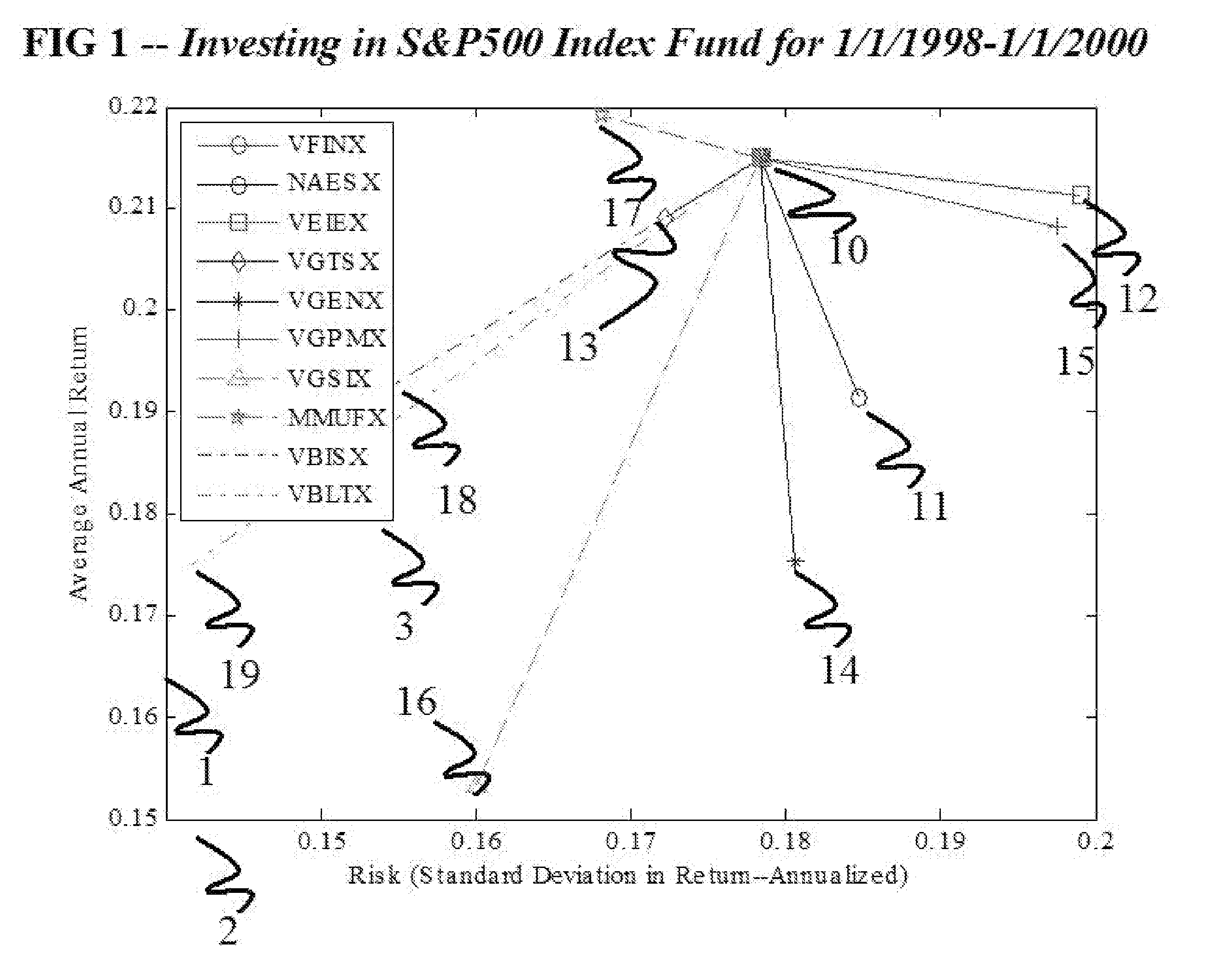Method and apparatus for characterizing the key properties and analyzing the future performance of an investment portfolio
a portfolio and key property technology, applied in the field of key property characterization and investment portfolio future performance analysis, can solve the problems of not providing verifiable and accurate tools, many are not useful, and many are not, and achieve the effect of increasing the correlation, increasing and reducing the diversification of the portfolio
- Summary
- Abstract
- Description
- Claims
- Application Information
AI Technical Summary
Benefits of technology
Problems solved by technology
Method used
Image
Examples
case 1
[0188] Ford Dec. 31, 2007, 12 month prediction
[0189]In this example, we generated a twelve-month outlook for Ford Motor Company (F), with a twelve-month look-back period. We constrained the tool to use data available only up to and including Dec. 31, 2007. The input screen is shown in FIG. 12.
[0190]We have chosen to use six core asset classes 121, and the Database 122 used for the historical market data is called PR1, which is from where the historical stock data can be found). The ticker 123 for Ford is F. We used eleven years (132 months) of data 124, and this was chosen so that one could have ten years of test data (the first twelve months being used to generate parameters for the first forecast 125). More data is good as it provides more samples for the model. We used twelve years of data 126 in our validations. The model uses monthly data, so having the Last Date be Jan. 1, 2008 means that the model had Dec. 31, 2007 as its final data point 127. Button 128 can be used to select...
case 2
[0197] VFINX Dec. 31, 2007, 12 month prediction
[0198]VFINX is the Vanguard S&P 500 index fund. We performed an analysis showing what the tool would have shown as of Dec. 31, 2007, i.e., the outlook for 2008 (see FIG. 15). The current state for VFINX as of the end of 2007 was State Three 151 (see text at top of screen). In State Three, the S&P 500 has averaged 0.8% (less than 1% in return) 152 over the subsequent twelve months. The one-SD loss has been −14.98% 153. This means that investors who put their money into VFINX in this state have averaged less than 1% in return for the next year, and not infrequently lost 15%. The only worse state to buy VFINX is State Two 154.
[0199]When do you want to buy VFINX? States Zero and One are goods times to buy VFINX as they average substantial returns over the next twelve months (i.e., 21.8% and 11.9%). This is a momentum play. State Zero and State One mean that the S&P 500 has been doing very well relative to other asset classes for the last tw...
case 3
[0203] General Electric Dec. 31, 2007, Twelve Month Prediction
[0204]This is a similar case, but for General Electric (GE). We are looking at what the model would have shown us at the start of 2008. The current state at that time was State Four 161 as shown in FIG. 16.
[0205]State Four has historically been the worst time to buy GE in terms of average return and risk (as measured by the one-SD downside). The best time to buy GE is when it is in State Zero—GE appears to be dominated by momentum effects. The second best state in which to buy GE, however, is State Six. State Six means that GE has substantially under-performed, i.e., GE has under-performed all of the core assets. Buying in State Six is a bet on reversion to the mean: history suggests that GE has generated moderately good returns following a year of substantial under-performance.
[0206]The lower right hand chart shows how many of our historical periods have been in each state. The signature is of a highly concentrated portf...
PUM
 Login to View More
Login to View More Abstract
Description
Claims
Application Information
 Login to View More
Login to View More - R&D
- Intellectual Property
- Life Sciences
- Materials
- Tech Scout
- Unparalleled Data Quality
- Higher Quality Content
- 60% Fewer Hallucinations
Browse by: Latest US Patents, China's latest patents, Technical Efficacy Thesaurus, Application Domain, Technology Topic, Popular Technical Reports.
© 2025 PatSnap. All rights reserved.Legal|Privacy policy|Modern Slavery Act Transparency Statement|Sitemap|About US| Contact US: help@patsnap.com



